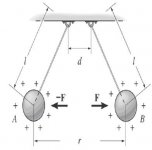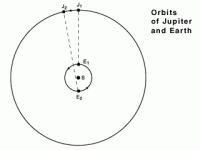Turns out we call it Eridanus "The River" these days.
Why the constellation Eridanus is called "The River" becomes apparent when we see its arrangement of stars (see attachment).
The bottom star Achernar, that Steve mentions, is 144 light years from Earth and its traditional name means "River's End".
Achernar is a very peculiar star because it is one of the flattest stars known. Observations indicate that its radius is about 50% larger at the equator than at the poles. This flattening occurs because the star is spinning extremely rapidly.
Attachments
Achernar, my favorite.Why the constellation Eridanus is called "The River" becomes apparent when we see its arrangement of stars (see attachment).
The bottom star Achernar, that Steve mentions, is 144 light years from Earth and its traditional name means "River's End".
Achernar is a very peculiar star because it is one of the flattest stars known. Observations indicate that its radius is about 50% larger at the equator than at the poles. This flattening occurs because the star is spinning extremely rapidly.
I was eager to sight Achernar and the South Cross in the Australian sky. 😀
Have finished Stephen Hawking's extremely long but stimulating book "On the Shoulders of Giants".
Copernicus, Galileo, Kepler, Newton, Einstein.
Most of this Historical Physics was based on precise Astronomical observations.
Copernicus stated some clear ideas, such as the Earth goes round the Sun. Somehow divined the existence of Atoms. But a severe WEAKNESS in his idea of everything being Circles.
Galileo was a bit of a Mechanical Engineer. Interested in the strengths of Materials. A practical man.
Kepler debunked Copernicus with his newer ideas about Ellipses, but wasted a lot of time with Platonic Solids being the basis of orbital ratios:
Law 1. A body remains at rest, or in motion at a constant speed in a straight line, unless acted upon by a force.
Law 2. When a body is acted upon by a force, the time rate of change of its momentum equals the force.
Law 3. If two bodies exert forces on each other, these forces have the same magnitude but opposite directions.
Lastly, Mr. Albert Einstein. He could contradict Himself. At one stage he said Mathematics without Experiment is meaningless. On the other hand he said that all is amenable to pure thought. You can't have it both ways, surely? 🙄
Anyway, a most interesting deduction from Physics and Astronomy ca. 1650.
Mr. Romer, an employee of Cassini, became interested in the Idea that since we couldn't build a decent Clock in 1650 to solve the problem of Longitude and Navigation, we might look to the Stars. He chose the emergence of Jupiter's Moon IO from eclipse as a useful measure. Alas there seemed to be a 22 minute discrepancy there. Easily explained if you consider the speed of Light being finite, combined with the radius of the Earh's orbit and the elliptical orbit of Jupiter.
The Matter of the speed of light was not settled until 1710. Surely a Child of Ten could have worked that one out. A setback of 60 years due to stupidity!
Interestingly, Newton and Einstein were both fans of a combined Gravitational and Electrical Force. Mr. Einstein calculated that the "Electron" is 1/4 Gravity and 3/4 Electromagnetism. Mr. Einstein also found flaws in Newtonian Gravity, as a simple attempt to avoid the Infinities. Thus adding a fudge factor we call the "Cosmological Constant".
Time will tell. Good News is the LHC is back online. 😎
Copernicus, Galileo, Kepler, Newton, Einstein.
Most of this Historical Physics was based on precise Astronomical observations.
Copernicus stated some clear ideas, such as the Earth goes round the Sun. Somehow divined the existence of Atoms. But a severe WEAKNESS in his idea of everything being Circles.
Galileo was a bit of a Mechanical Engineer. Interested in the strengths of Materials. A practical man.
Kepler debunked Copernicus with his newer ideas about Ellipses, but wasted a lot of time with Platonic Solids being the basis of orbital ratios:
- The orbit of a planet is an ellipse with the Sun at one of the two foci.
- A line segment joining a planet and the Sun sweeps out equal areas during equal intervals of time.
- The square of a planet's orbital period is proportional to the cube of the length of the semi-major axis of its orbit.
Law 1. A body remains at rest, or in motion at a constant speed in a straight line, unless acted upon by a force.
Law 2. When a body is acted upon by a force, the time rate of change of its momentum equals the force.
Law 3. If two bodies exert forces on each other, these forces have the same magnitude but opposite directions.
Lastly, Mr. Albert Einstein. He could contradict Himself. At one stage he said Mathematics without Experiment is meaningless. On the other hand he said that all is amenable to pure thought. You can't have it both ways, surely? 🙄
Anyway, a most interesting deduction from Physics and Astronomy ca. 1650.
Mr. Romer, an employee of Cassini, became interested in the Idea that since we couldn't build a decent Clock in 1650 to solve the problem of Longitude and Navigation, we might look to the Stars. He chose the emergence of Jupiter's Moon IO from eclipse as a useful measure. Alas there seemed to be a 22 minute discrepancy there. Easily explained if you consider the speed of Light being finite, combined with the radius of the Earh's orbit and the elliptical orbit of Jupiter.
The Matter of the speed of light was not settled until 1710. Surely a Child of Ten could have worked that one out. A setback of 60 years due to stupidity!
Interestingly, Newton and Einstein were both fans of a combined Gravitational and Electrical Force. Mr. Einstein calculated that the "Electron" is 1/4 Gravity and 3/4 Electromagnetism. Mr. Einstein also found flaws in Newtonian Gravity, as a simple attempt to avoid the Infinities. Thus adding a fudge factor we call the "Cosmological Constant".
Time will tell. Good News is the LHC is back online. 😎
Last edited:
Interestingly, Newton and Einstein were both fans of a combined Gravitational and Electrical Force.
I read that Newton became convinced towards the end of his life that electricity played a vital role in the operations of nature.
His interest was drawn to the forces of attraction and repulsion between objects that had been charged by friction (by rubbing).
(There's no better illustration of Newton's third law than the mutual attraction or repulsion of two charged spheres suspended from long fibres.)
Newton attributed electrical forces to an "electric and elastic spirit" which permeates and lies hidden in all material objects.
Not bad thinking for 1713 when the second edition of the Principia was published!
Attachments
Good News is the LHC is back online. 😎
May the Fifth Force be with you! 😀
Attachments
Motion Mountain are seriously engaging books on physics but such a pity that the author has decided to deride Newton at every turn because he dabbled in the occult and in alchemy. Christpher Schiller seems to have forgotten that Newton lived and worked 350 yrs ago.
Alas there seemed to be a 22 minute discrepancy there ... The Matter of the speed of light was not settled until 1710.
I read that in 1675, Roemer estimated that light required 22 minutes to cross the diameter of the Earth’s orbit.
The speed of light could then be calculated by dividing the diameter of the Earth’s orbit by that time.
When the calculation was finally done, the answer was 131,000 miles/second, while the correct value is around 186,000 miles/second.
This was because Roemer's estimate of 22 minutes was in error and the correct value is 16.7 minutes.
However, more important than the correct answer, Roemer's was the first quantitative estimate for the speed of light, and it was in the right ballpark.
https://www.amnh.org/learn-teach/cu...osmic-horizons-book/ole-roemer-speed-of-light
I don't know what happened in the year 1710, other than that it is the year in which Roemer died!

It wasn't until 1849 that Fizeau, who sent light through a rotating tooth wheel and then reflected it back with a mirror, obtained a value close to today's accepted value.
(In the attached diagram, E1 is the position of the Earth when it is closest to Jupiter and E2 is when it is furthest away 6.5 months later.)
Attachments
No, I checked this. Everybody now knows (A Child of Ten an' all that) it takes 8.5 minutes for the Sun's light to reach the Earth. Thus giving a maximum error of 17 minutes,
But Jupiter has an eccentric orbit. A half Astronomical Unit. 21 Minutes I would accept. 22 Minutes is surprisingly good. Near enough, IMO.
TBH, I find Radians less confusing.
But Jupiter has an eccentric orbit. A half Astronomical Unit. 21 Minutes I would accept. 22 Minutes is surprisingly good. Near enough, IMO.
TBH, I find Radians less confusing.
Last edited:
The inaccuracy of the measurement of the diameter of the Earth's orbit at that time also contributed to the inaccurate value for the speed of light.
No, I checked this.
I understand, Steve.
You are saying that Roemer's estimate of the 22 minute time difference was not "in error" as I said in my post.
Roemer discovered that light from Jupiter took longer to reach the Earth when it was on the opposite side of the Sun from Jupiter, thus demonstrating that light has a finite speed and is not instantaneous as was claimed by Kepler.
In his only publication about the speed of light, Roemer's sole message is that the speed of light is finite, though incredibly large. Roemer did not mention any specific value.
It was Huygens who, later in 1678, calculated a figure for the speed of light using Roemer's estimate - a figure which in modern measurements was nearer to 200,000,000 m/s than 300,000,000 m/s.
There's some interesting history here: https://physicstoday.scitation.org/...m/s.?msclkid=5b6123bdc3bd11ecb8914b2711aa6ee7
That's Veritasium's Hot Take Of The Month, "Why No One Has Measured The Speed Of Light." He caused an even bigger stir with the video "The Big Misconception About Electricity."
"Why No One Has Measured The Speed Of Light."
The question that is actually being asked is "Why has no one ever measured the speed of light it in one direction?"
The two-way speed of light is the average speed of light from one point, such as a light source, to a mirror and back again - as in Fizeau's measurement or in the Michelson interferometer.
Although the average speed over a two-way path can be measured, the one-way speed in one direction or the other is undefined.
Some experiments have claimed to have measured the one-way speed of light, but it turns out they actually measured the two-way speed of light.
At first glance, it looks like Roemer determined the one-way speed of light by measuring the time for light to cross the Earth's orbit, but in fact it can be shown to be a two-way measurement.
It's all to do with the way clocks are synchronised and to explain that is too complicated for little old googler me!

I still stick to my original theory when I was 15 years old 42 years ago. It expanss into nothingness and then under its own pool it collapses back into a finite point to repeat the big bang again and start everything all over again time after time
His final statement is an indelibly intuitive link to the ongoing mystery of our reality. The idea that light is indeed infinitely fast is a very profound insight that reconciles our human perception on more than one level. Gotta wonder what Einstein's thoughts really were about this possibility.That's Veritasium's Hot Take Of The Month, "Why No One Has Measured The Speed Of Light." He caused an even bigger stir with the video "The Big Misconception About Electricity."
It's all to do with the way clocks are synchronised...
This explanation may be over simplified, but it'll do for me!
For a two-way measurement of the speed of light you need only situate one 'clock' at the source in order to measure both the time of departure of the light beam and its time of return.
However, for a one-way measurement of the speed of light, you would need two 'clocks' - one at the source to measure the time of departure of the light beam and another at the distant end of journey point to measure its time of arrival. The big problem is, how do you synchronise these two clocks? That is the problem that lies at the heart of why a one-way measurement of the speed of light has not been made.
Last edited:
It expanss into nothingness and then under its own pool it collapses back into a finite point to repeat the big bang again and start everything all over again time after time
Ah, you're another enthusiast of the "Big Crunch" and the "Cyclic Universe" theory.
https://www.accessscience.com/conte...el of,“big bang” and ending in a “big crunch”.
TNT would be happy in your company! 😀
#GPS
I'm not an expert on GPS (mchambin may be able to help), but I see that in GPS we can refer to one-way or two-way tracking.
One-way tracking involves one signal transmitter with a stable frequency reference and one receiver.
Two-way tracking requires the use of an additional transponder.
So, benb, help me out - how does this relate to measuring the speed of light?
- Status
- Not open for further replies.
- Home
- Member Areas
- The Lounge
- What is the Universe expanding into..



